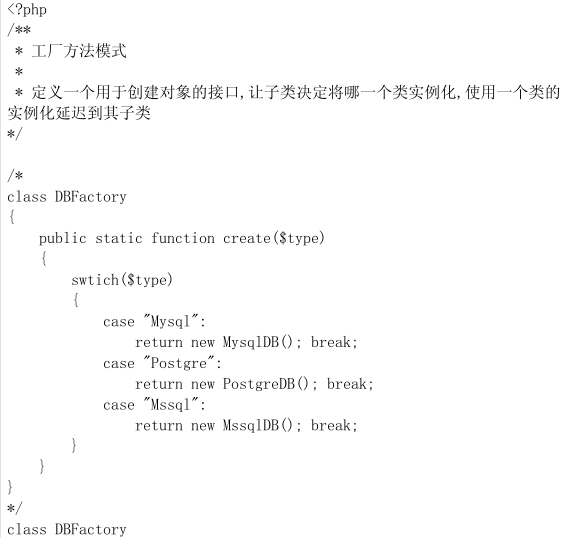
The purpose of using design patterns: for code reusability, to make the code easier to understand by others, and to ensure code reliability. Design patterns make code writing truly engineering; design patterns are the cornerstone of software engineering, just like the structure of a building.
Web page production28646532018-02-11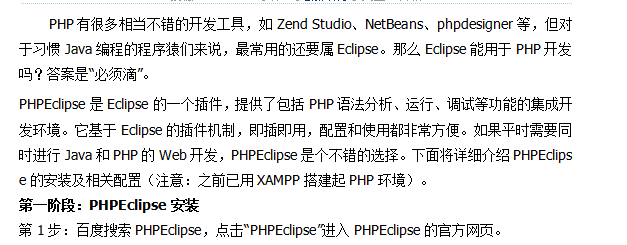
The functions of the PHPeclipse plug-in include: PHP syntax analysis, debugging, code formatting, outline view, code template customization, etc. If you want to make some java and php web applications at the same time, you need to use Eclipse. You can install PHPeclipse and MyEclipse, so that Eclipse can develop ajax, php, and jsp programs at the same time. Install Apache, Tomcat and php, Mysql and Eclipse plug-ins (Eclipse + MyEclipse + Phpeclipse)
Web page production28641752018-02-11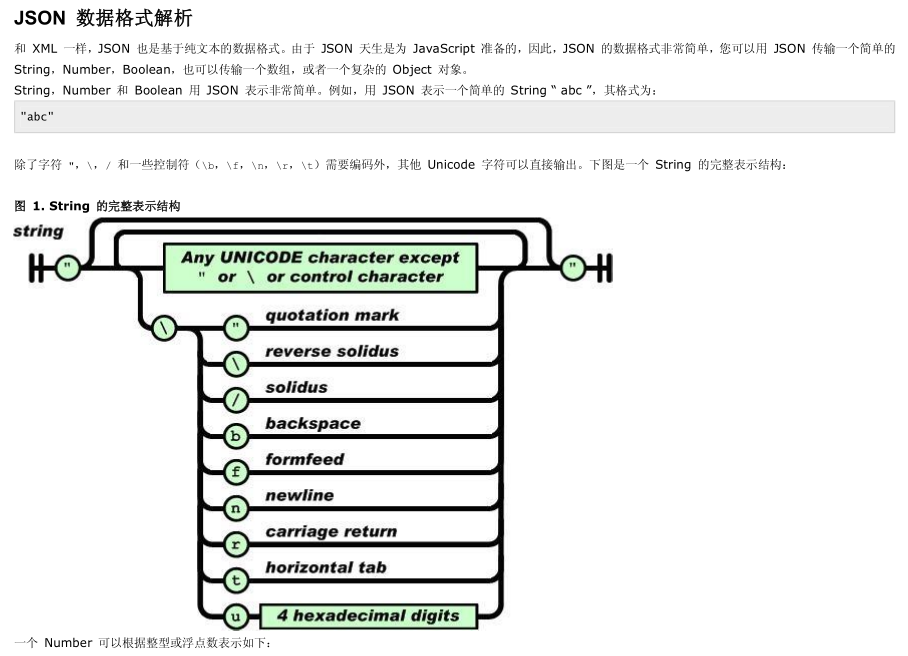
JSON (JavaScript Object Notation, JS Object Notation) is a lightweight data exchange format. It is based on a subset of ECMAScript (the js specification developed by w3c) and uses a text format that is completely independent of programming languages to store and represent data. Simplicity and clear hierarchical structure make JSON an ideal data exchange language. It is easy for people to read and write, and it is also easy for machines to parse and generate, and effectively improves network transmission efficiency.
Web page production28644942018-02-11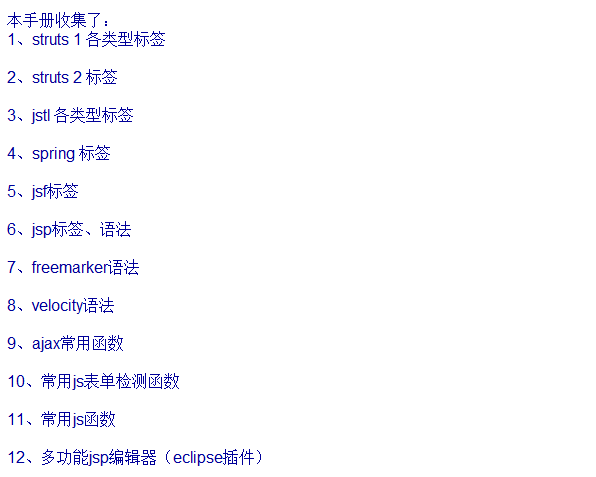
<span style="font-family:Verdana, Geneva, Arial, Helvetica, sans-serif;font-size:13px;"> The <jsp:include> tag is used to insert the output content of another resource into the current JSP page Among the output content, this introduction method when the JSP page is executed is called dynamic introduction. </span><br /> Syntax:<br /> <jsp:include page="relativeURL | <%=expression%>" flush="true|false" /><br /> The page attribute is used to specify the relative path of the imported resource, which can also be obtained by executing an expression. <br /> The flush attribute specifies whether to flush the output content of the current JSP page to the client first when inserting the output content of other resources.
Web page production28646962018-02-11
Take group purchase management in promotion as an example<br /> 1. Setting menu<br /> Find the menu.inc.php file in tjb2c\admin\includes and add the following code:<br /> <br /> //Promotion<br /> 'cuxiao' => array(<br /> 'default' => 'children' => array(<br /> 'dazhe_manage' => array(<br /> 'text' => "Limited time discount",<br /> 'Url' = & gt; 'Index.php? APP = dazhe & Act = Add', <br /> ),<br /> 'groupbuy' => array(<br /> 'text' => Lang::get('groupbuy'),<br /> 'url' => 'index.php?app=groupbuy',<br /> ),<br /> <br /> ),<br /> ), <br />
Web page production28643632018-02-11
DuiEngine License<br /> <br /> The MIT License (MIT)<br /> Copyright (c) <year> <copyright holders><br /> <br /> Permission is hereby granted, free of charge, to any person obtaining a copy of this software and associated documentation files (the "Software"), to deal in the Software without restriction, including without limitation the rights to use, copy, modify, merge, publish, distribute, sublicense, and/or sell copies of the Software, and to permit persons to whom the Software is furnished to do so, subject to the following conditions:<br /> <br /> The above copyright notice and this permission notice shall be included in all copies or substantial portions of the Software.<br /> <br /> THE SOFTWARE IS PROVIDED "AS IS", WITHOUT WARRANTY OF ANY KIND, EXPRESS OR IMPLIED, INCLUDING BUT NOT LIMITED TO THE WARRANTIES OF MERCHANTABILITY, FITNESS FOR A PARTICULAR PURPOSE AND NONINFRINGEMENT. IN NO EVENT SHALL THE AUTHORS OR COPYRIGHT HOLDERS BE LIABLE FOR ANY CLAIM, DAMAGES OR OTHER LIABILITY, WHETHER IN AN ACTION OF CONTRACT, TORT OR OTHERWISE, ARISING FROM, OUT OF OR IN CONNECTION WITH THE SOFTWARE OR THE USE OR OTHER DEALINGS IN THE SOFTWARE.<br /> <br /> <br />
Web page production28645312018-02-11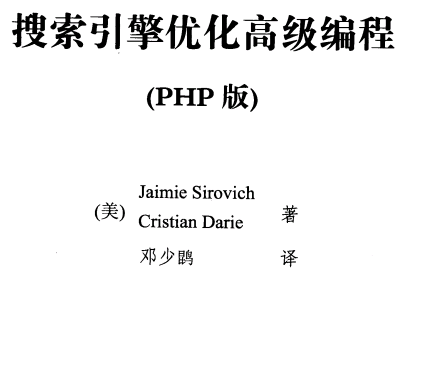
Search engine optimization has traditionally been the job of the marketing team. But in this book, the author will look at search engine optimization from another perspective and allow programmers to participate in the search engine optimization team. <br /> This manual is specially written for PHP developers or marketers involved in technology, covering the entire process from the initial idea of a Web site, technical planning, visual design, and through-development. This book provides an in-depth discussion of various technologies and services that can be used to improve site visibility, and provides a lot of useful information to help you create and maintain a search engine-friendly Web site and avoid some common mistakes. This book can be used as a teaching material by various colleges and universities, and can also be used as a reference book by those engaged in related work. <br />
php e-book28682892018-02-10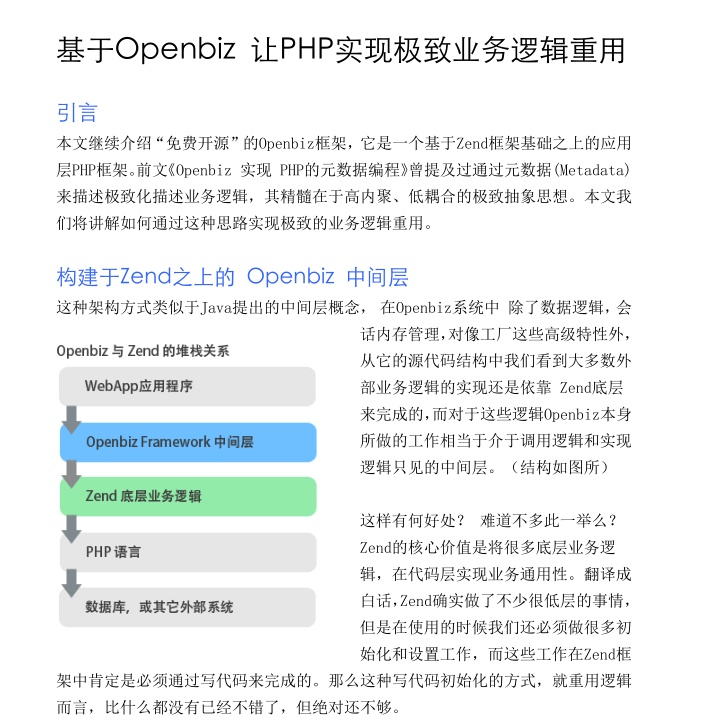
Introduction <br /> This article continues to introduce the "free and open source" Openbiz framework, which is an application layer PHP framework based on the Zend framework. The previous article "Openbiz implements PHP metadata programming" mentioned that metadata (Metadata) is used to describe the ultimate description of business logic. The essence lies in the ultimate abstract idea of high cohesion and low coupling. In this article, we will explain how to achieve ultimate business logic reuse through this idea. The architecture of the Openbiz middle layer built on Zend is similar to the middle layer concept proposed by Java. In the Openbiz system, in addition to advanced features such as data logic, session memory management, and object factories, we can see from its source code structure It can be seen that the implementation of most external business logic still relies on the bottom layer of Zend, and the work done by Openbiz itself for these logics is equivalent to the middle layer between the calling logic and the implementation logic. What are the benefits of this? Isn't it unnecessary? The core value of Zend is to realize business versatility at the code level by integrating many underlying business logics. Translated into vernacular, Zend does do a lot of low-level things, but when using it, we must also do a lot of initialization and setup work, and these tasks must be completed by writing code in the Zend framework. So this way of writing code initialization is better than nothing in terms of reusing logic, but it is definitely not enough. <br />
php e-book28673182018-02-10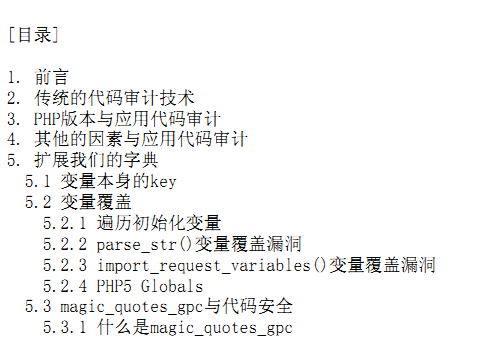
Advanced PHP application vulnerability audit technology PDF e-book mainly introduces vulnerabilities and prevention technologies in various versions of PHP, avoiding the occurrence of vulnerabilities through code or other means, and allowing PHP projects to run safely
php e-book28678532018-02-10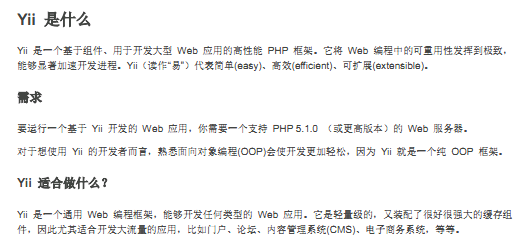
A simple command line tool yiic can quickly create a web application code framework. Developers can add business logic based on the generated code framework to quickly complete application development. This version contains more than 90 new features, Enhancements and bug fixes, the most important ones are: RESTful URL support, query caching, class-based Actions parameter binding, seamless client validation, passing parameters to relational named scope, using through in HAS_MANY and HAS_ONE, database migration Transaction processing and support for registering and using custom script packages, etc.
php e-book28678022018-02-10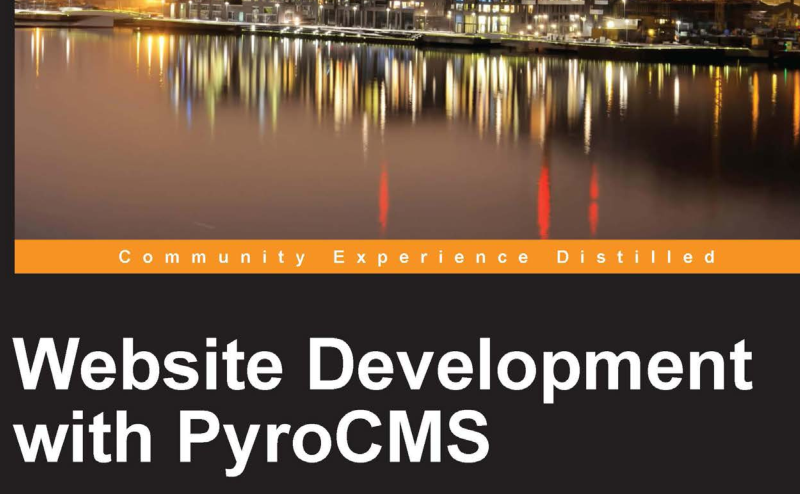
Introduction<br /> PyroCMS is a PHP content management system (CMS) with MVC architecture. It is easy to use, modular, supports multiple themes and secondary development, and is widely used around the world. Versions before 3.0 were developed based on the CodeIgniter framework. The current main version is 3.0, based on Laravel 5.1. <br /> Installation<br /> System requirements, before installation, make sure the server meets the following requirements:<br /> PHP >= 5.5.9<br /> OpenSSL extension<br /> PDO extension<br /> Mbstring extension<br /> Tokenizer extension<br /> Fileinfo extension<br /> GD library (>=2.0) or Imagick extension (>=6.5.7)<br />
php e-book28681052018-02-10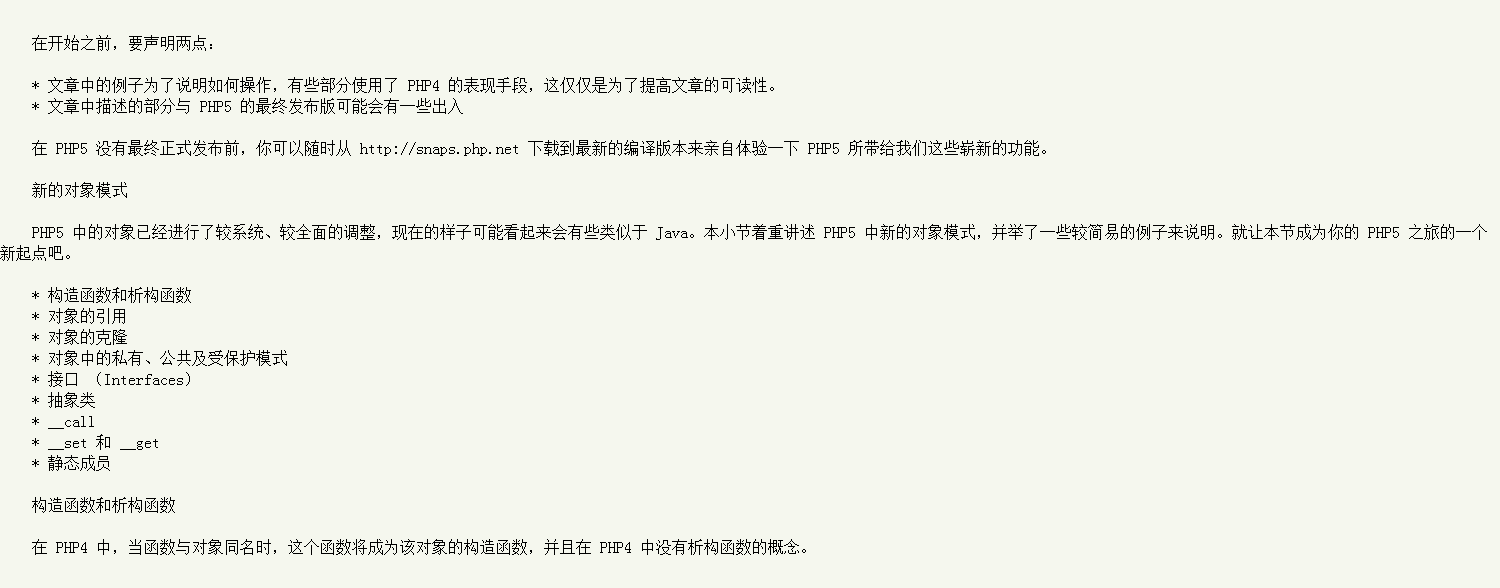
Summary of PHP learning materials <br /> Table of Contents <br /> A first look at PHP5-1 <br /> A first look at PHP5_2 <br /> A first look at PHP5_3 <br /> A first look at PHP5_4 <br /> Learn php in ten days 01 <br /> Learn php in ten days 02 <br /> Learn php in ten days 03 <br /> Learn php in ten days 04 <br /> Learn php in ten days 05 <br /> Learn php in ten days 06 <br /> Learn php in ten days 07 <br /> Learn php in ten days 08 <br /> Learn php in ten days 09 <br /> Learn php in ten days 10 <br /> PHP4 Practical Application Experience (1) <br /> PHP4 Practical Application Experience (2) <br /> PHP4 Practical Application Experience (3) <br /> PHP4 Practical Application Experience (4) <br /> PHP4 Practical Application Experience (5) <br /> PHP4 Practical Application Experience (6) <br /> PHP4 Practical Application Experience (7) <br /> PHP4 Practical Application Experience (8) <br /> PHP4 Practical Application Experience (9) <br /> Method of calling MySQL database by PHP 0 <br /> PHP and MySQL basic tutorial 1 <br /> PHP and MySQL Basic Tutorial 2 <br /> PHP and MySQL Basic Tutorial 3 <br /> PHP and MySQL Basic Tutorial 4 <br /> PHP-MySQL Tutorial 1 <br /> PHP-MySQL Tutorial 2 <br /> PHP-MySQL Tutorial 3 <br /> PHP-MySQL Tutorial 4 <br /> PHP-MySQL Tutorial 5 <br /> PHP-MySQL Tutorial 6 <br /> PHP-MySQL Tutorial 7 <br /> PHP-MySQL Tutorial 8 <br /> A brief discussion of PHP syntax (1) <br /> Talk about PHP syntax (2) <br /> Talk about PHP syntax (3) <br /> Talk about PHP syntax (4) <br /> Talk about PHP syntax (5) <br /> PHP Chinese text data page turning (guestbook page turning) 0 <br /> An example of a text guestbook made in PHP 1 <br /> Example 2 of a text guestbook made in PHP <br /> Example 3 of a text guestbook made in PHP <br /> Example 4 of a text guestbook made in PHP <br /> Example 5 of a text guestbook made in PHP <br /> Example 6 of a text guestbook made in PHP <br /> Chat room design based on PHP+MySQL 0 <br /> PHP Design Chat Room Step by Step 1 <br /> PHP design chat room step by step 2 <br /> PHP design chat room step by step 3 <br /> PHP design chat room step by step 4 <br /> Detailed explanation of COOKIE support in PHP4 <br /> PHP+MYSQL article management system <br /> PHP+MySQL paging display example analysis <br /> PHP programming skills: learn regular expressions through examples <br /> Advanced skills in PHP programming - using Mysql functions <br /> Three ways to access and query mysql data in php <br /> Detailed explanation of PHP pagination display production <br /> Detailed explanation of session application in PHP development <br /> PHP control statements <br /> Quick Start with PHP Object-Oriented Programming <br /> php generates html files <br /> PHP variables for PHP learning <br /> PHP expressions for PHP learning <br /> PHP operators for PHP learning <br /> PHP User Guide-Cookies Section <br /> Several "abnormal" uses of for loop statements in PHP <br /> MD5 encryption in PHP <br /> Serialized variables and serialized pairs in PHP <br /> How Session works <br /> Personal web page automatic generation system <br /> Simple page buffering technology <br /> A brief discussion on template selection in PHP program development <br /> Examples of learning PHP form processing <br /> Example of learning PHP voting program <br /> Summary of questions <br /> Write a program for user online display <br /> Build a guestbook with PHP <br /> Use PHP to realize dynamic WEB web page static <br /> Specific ideas and implementation of file upload using PHP <br /> Use PHP to create a template framework for static websites <br /> Correctly understand error messages when compiling PHP programs <br /> The fourteen most troublesome problems for PHP beginners <br />
php e-book28699962018-02-10
"Full Record of PHP Project Development Cases" is a book published by Tsinghua University Press in 2011. The author is Tomorrow Technology. <br /> "Full Record of PHP Project Development Cases" is based on Jiujiudu supply and demand information network, BCTY365 online community, office automation management system, e-commerce platform network, online online examination system, logistics and distribution information network, school library management system, blog management system, 12 actual project development programs of Enterprise Express System, Online Film and Television 365 Network, Tomorrow Knows website and e-commerce website are used as cases. From the perspective of software engineering, according to the project development sequence, the program development process is systematically and comprehensively introduced. From development background, requirements analysis, system function analysis, database analysis, database design, website development to website publishing, each process is introduced in detail. <br /> The cases of "Full Record of PHP Project Development Cases" cover a wide range of industries and are very practical. By studying this book, readers can understand the characteristics of each industry and develop websites for a certain industry. They can also use the case sources provided on the CD The code and database are redeveloped to reduce the time required to develop the system. The CD-ROM of this book provides synchronous teaching videos of 12 complete project development cases, 12 complete project development cases and their source programs. The service website of this book also provides a rich material library, question library, module library, case library and this book. Q&A service. <br />
php e-book28700052018-02-10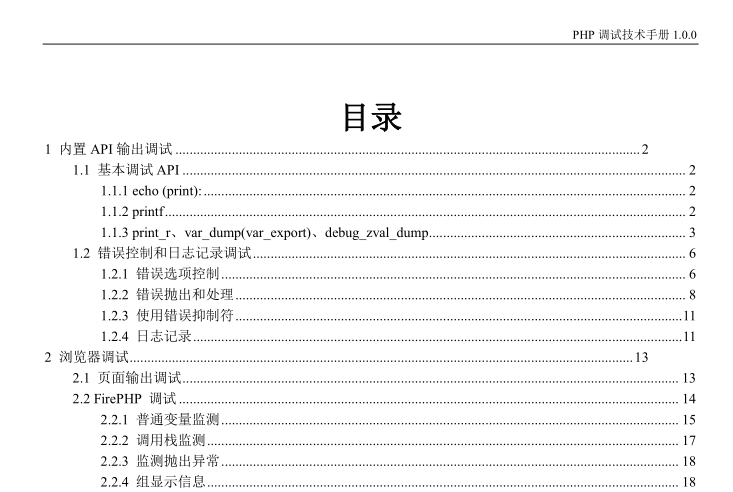
1 Built-in API output debugging<br /> 1.1 Basic debugging API<br /> 1.1.1 echo (print):<br /> 1.1.2 printf<br /> 1.1.3 print_r, var_dump(var_export), debug_zval_dump<br /> 1.2 Error control and logging debugging<br /> 1.2.1 Error option control<br /> 1.2.2 Error throwing and handling<br /> 1.2.3 Use error suppressors<br /> 1.2.4 Logging<br /> 2 Browser debugging<br /> 2.1 Page output debugging<br /> 2.2 FirePHP Debugging<br /> 2.2.1 Common variable monitoring<br /> 2.2.2 Call stack monitoring<br /> 2.2.3 Monitoring exceptions thrown<br /> 2.2.4 Group display information<br /> 3 IDE debugging<br /> 3.1 Introduction to basic commonly used IDEs<br /> 3.1.1 Vim<br /> 3.1.2 Zend Studio<br /> 3.1.3 Eclipse<br /> 3.1.4 NetBeans<br /> 3.2 IDE debugging<br /> 3.2.1 Zend Studio + Zend Debugger<br /> 3.2.2 Eclipse (PDT) + Xdebug<br /> 3.2.3 Vim + Xdebug + DBGp<br /> 4 PHP performance debugging technology<br /> 4.1 Basic time occupancy monitoring<br /> 4.2 Use Xdebug for performance analysis<br /> 4.2.1 Installation configuration:<br /> 4.3 APD(Advanced PHP Debugger)<br /> 4.3.1 Installation configuration<br /> 4.3.2 Using APD<br /> 4.4 Use Xhprof for performance analysis<br /> 4.4.1 Advantages of Xhprof:<br /> 5 PHP unit testing technology<br /> 5.1 PHPUnit<br />
php e-book28690462018-02-10
<span style="color:#333333;font-family:Arial, Helvetica, sans-serif, Song Dynasty, Helvetica;">Writing extension I: Getting started with PHP and Zend Writing extension I: Getting started with PHP and Zend extension tutorial by Sara Golemon | Monday, February 28, 2005 Introduction What are extensions? Lifecycle Memory allocation Set up the build environment Hello World Build your extension Initial settings (INI) as global values Initial settings (INI) as global values Check (code) integrity What's next? Introduction Since you are reading this tutorial, you may be interested in writing extensions to the PHP language. If it wasn't...well, maybe you didn't know about this interest, you'll find it out by the time we wrap up. This tutorial assumes you have basic familiarity with the PHP language and the language its interpreter is implemented in: C. Let's start by specifying why you want to write a PHP extension. 1. Limited to the level of abstraction of the PHP language itself, it cannot directly access certain libraries or operating system-specific calls. 2. You want to customize the behavior of PHP in some unusual way. 3. You have some existing PHP code, but you know it can be faster, smaller, and consume less memory. </span>
php e-book28681062018-02-10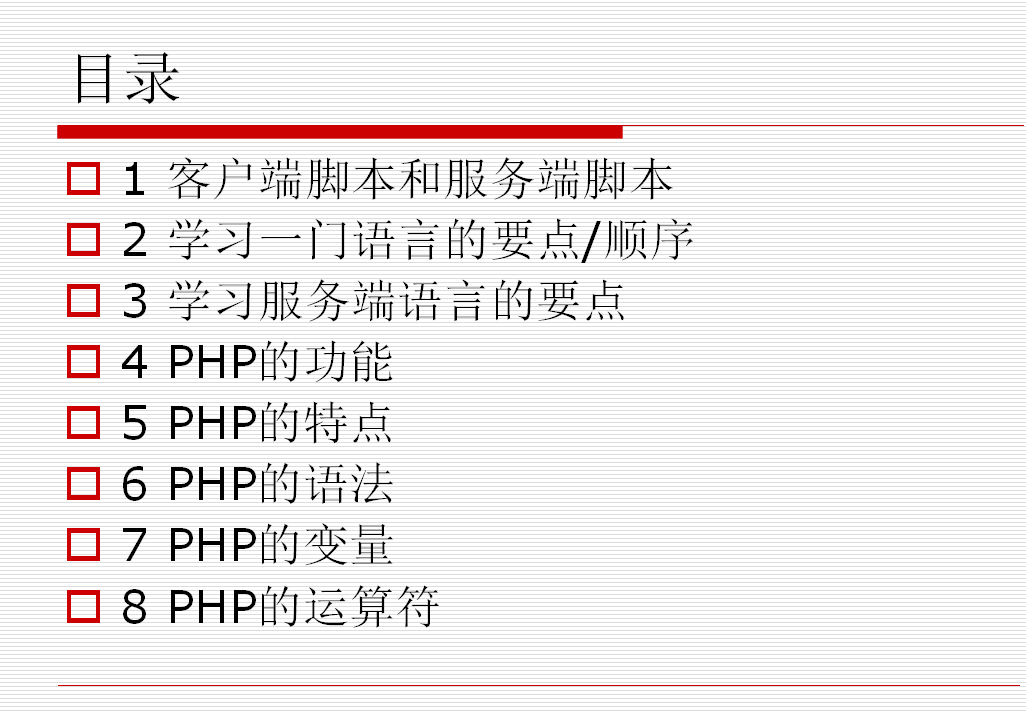
1Learn PHP in 3 minutes<br /> 2PHP environment installation takes 5 minutes<br /> <br /> 3Everyone can code in 6 minutes<br /> <br /> 4 variables 8 minutes<br /> <br /> 1) A variable is an empty box with a name. The process of a box holding content is called assignment (=)<br /> <br /> 2) Different types of boxes (types of variables) can hold different things<br /> <br /> 5 operators 10 minutes<br /> <br /> +,-,*,/,=<br /> <br /> 6 Three major control structures11 minutes<br /> <br /> Sequence, loop, control<br /> <br /> 7You’ve learned to program in 6 minutes<br /> <br /> Once you learn variables, operators, and control, you will learn to program<br /> <br /> 8 variable data types 7 minutes<br /> <br /> Variables: starting with $ as flag<br /> <br /> 9 strings 6 minutes<br /> <br /> $str = "I love you";//Form of double quotes<br /> <br /> $str0 = 'I love you';//Form of single quotes<br /> <br /> In single quotes, only two escapes are recognized, \' is ' \\ is \<br /> <br /> 10 arrays 8 minutes<br /> <br /> $arr =array("001"=>"li","002"=>"zhang")<br /> <br /> The array is the cabinet. The number of the cabinet specifies a specific cabinet and the things are placed in the cabinet<br /> <br /> You need a key to find something, and a key to put something in (key ---->value)<br /> <br /> 11GET POST form data 10 minutes<br /> <br /> 12 Guestbook publishing function 11 minutes<br /> <br /> 13Guestbook: 17 minutes to read messages<br /> <br /> 14 Learning methods: How to learn PHP efficiently? 19 minutes<br /> <br /> Author: bad_boy<br /> Link: https://www.jianshu.com/p/dfa48c5a2cac<br /> Source: Jianshu<br /> Copyright belongs to the author. For commercial reprinting, please contact the author for authorization. For non-commercial reprinting, please indicate the source. <br />
php e-book28676592018-02-10
Preliminary preparation:<br /> Of course, the most basic prerequisite is to at least roughly learn the syntax of PHP. <br /> 1. Install related software, such as Sublime text, Notepad++, editplus, Seay source code audit system, etc.<br /> 2. Obtain the source code and download the source code of various websites online<br /> 3. Install the website<br /> <br /> Audit method:<br /> Read the whole text: troublesome but comprehensive<br /> Sensitive function parameter backtracking method: efficient and commonly used, Seay source code audit system<br /> Targeted function analysis method: mainly audit based on the business logic of the program. First, use the browser to access one by one to see what functions the program has, and speculate on possible vulnerabilities based on the relevant functions<br /> <br /> Basic audit process:<br /> 1. Overall understanding<br /> 2. Conduct audits for each function according to the directed function method<br /> 3. Sensitive function parameter backtracking method<br />
php e-book28683922018-02-10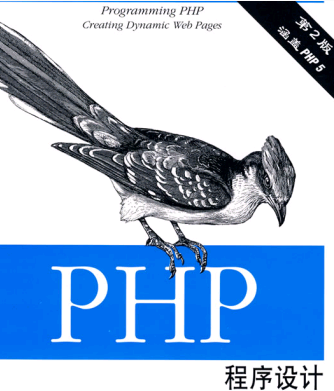
Table of Contents <br /> Chapter 1 Introduction to php 1 <br /> 1.1. What can php do? 1 <br /> 1.2. A brief history of php development 2 <br /> 1.3. Install php 7 <br /> 1.4. php overview 9 <br /> Chapter 2 Language Basics 18 <br /> 2.1. Lexical Structure 18 <br /> 2.2. Data type 25 <br /> 2.3. Variable 32 <br /> 2.4. Expressions and Operators 36 <br /> 2.5. Flow control statements 49 <br /> 2.6. Contains code 57 <br /> 2.7. Embedding php 59 in web pages <br /> Chapter 3 Functions 63 <br /> 3.1. Function call 63 <br /> 3.2. Defining functions 64 <br /> 3.3. Variable scope 66 <br /> 3.4. Function parameters 68 <br /> .3.5. Return value 71 <br /> 3.6. Variable functions 72 <br /> 3.7. Anonymous function 73 <br /> Chapter 4 Strings 74 <br /> 4.1. Quoting string constants 74 <br /> 4.2. Output string 78 <br /> 4.3. Accessing a single character 82 <br /> 4.4. Organize strings 82 <br /> 4.5. Encoding and escaping 83 <br /> 4.6. Compare strings 89 <br /> 4.7. Processing and Finding Strings 91 <br /> 4.8. Regular Expressions 97 <br /> 4.9. Styled Regular Expressions 101 <br /> 4.10. perl compatible regular expressions 106 <br /> Chapter 5 Arrays 119 <br /> 5.1. Indexed Arrays and Associative Arrays 119 <br /> 5.2. Identify array elements 120 <br /> 5.3. Storing data in an array 120 <br /> 5.4. Multidimensional array 123 <br /> 5.5. Extract multiple values 123 <br /> 5.6. Converting between arrays and variables 127 <br /> 5.7. Traverse array 128 <br /> 5.8. Sort 133 <br /> 5.9. Acts on the entire array 138 <br /> 5.10. Using array 140 <br /> Chapter 6 Object 143 <br /> 6.1. Terminology 144 <br /> 6.2. Create an object 144 <br /> 6.3. Accessing object properties and methods 145 <br /> 6.4. Declare a class 146 <br /> 6.5. Introspection 153 <br /> 6.6. Serialization 159 <br /> Chapter 7 web technology 164 <br /> 7.1. http basics 164 <br /> 7.2. Variable 165 <br /> 7.3. Server information 166 <br /> 7.4. Form processing 168 <br /> 7.5. Set response header 182 <br /> 7.6. Maintain status 185 <br /> 7.7. ssl 195 <br /> Chapter 8 Database 196 <br /> 8.1. Use php to access the database 196 <br /> 8.2. Relational databases and 198 <br /> 8.3. pear db basics 199 <br /> 8.4. Advanced Database Technology 205 <br /> 8.5. Sample program 211 <br /> Chapter 9 Graphics 225 <br /> 9.1. Embed images in pages 225 <br /> 9.2. gd extension 226 <br /> 9.3. Basic concepts of images 227 <br /> 9.4. Creating and drawing images 228 <br /> 9.6. Dynamically create buttons 236 <br /> 9.7. Zoom image 239 <br /> 9.8. Color processing 240 <br /> Chapter 10 pdf 246 <br /> 10.1. pdf extension 246 <br /> 10.2. Documents and Pages 246 <br /> 10.3. Text 248 <br /> xml 261 <br /> 11.1. Getting Started 261 <br /> 11.2. Generate xml 263 <br /> 11.3. Parse xml 264 <br /> 11.4. Parse xml with dom 277 <br /> 11.5. Use simplexml to parse xml 277 <br /> 11.6. Convert xml using xslt 278 <br /> 11.7. web services 280 <br /> Chapter 12 Security 285 <br /> 12.1. Input filtering 285 <br /> 12.2. escape output 290 <br /> 12.3. Cross-site scripting attacks 293 <br /> 12.4. session forgery 294 <br /> 12.5. File upload 295 <br /> 12.6. File access permissions 296 <br /> 12.7. php code 299 <br /> 12.8. shell command 300 <br /> 12.9. More information 301 <br /> 12.10. Summary of safety points 301 <br /> Chapter 13 Application Technology 302 <br /> 13.1. Codebase 302 <br /> 13.2. Template system 303 <br /> 13.3. Output processing 306 <br /> 13.4. Error handling 308 <br /> 13.5. Performance Tuning 313 <br /> Chapter 14 Extending PHP 321 <br /> 14.1. Architecture Overview 321 <br /> 14.2. What it takes to write an extension 322 <br /> 14.3. Create your first extension 323 <br /> 14.4. config.m4 file 333 <br /> 14.5. Memory Management 336 <br /> 14.6. type pval/zval data type 338 <br /> 14.7. Parameter handling 342 <br /> 14.8. Return value 345 <br /> 14.9. Quote 349 <br /> 14.10. Global variables 350 <br /> 14.11. Create variables 354 <br /> 14.12. Extended ini items 355 <br /> 14.13. Resources 357 <br /> 14.14. Next/Aftermention 359 <br /> Chapter 15 PHP on Windows 359 <br /> 15.1. Install and configure php 359 under windows <br /> 15.2. Writing portable code for windows and unix platforms 363 <br /> 15.3. Interacting with com 366 <br /> 15.4. Data Source Interaction 372 <br /> Appendix a Function Reference 377
php e-book28682552018-02-10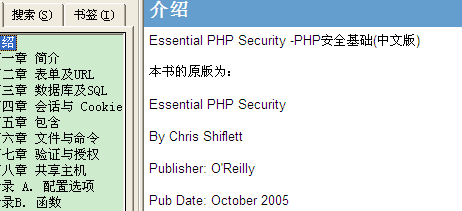
As PHP projects grow, software design and organization play an increasingly important role in code maintainability. Although there are many opinions about the best way to program (and debates about the merits of object-oriented programming often occur), basically every developer will understand and appreciate the value of modular design. <br /> This chapter explains the security issues you face when using includes. Include or require files in a script divide your application into two logically separate parts. I'll also highlight and correct some common misconceptions, especially about how to program.
php e-book28679912018-02-10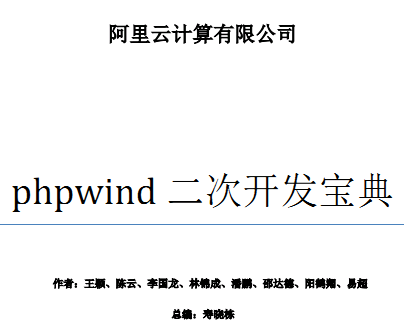
<div style="padding:0px;margin:0px;"> phpwind secondary development guide<br /> <br /> Table of Contents <br /> Data query (CRUD). 4 <br /> Portal secondary development system 13 <br /> 1. How to call the PORTAL module in the page, similar to calling a module such as "Broadcast Station" in the page 13 <br /> 2. How to customize methods in portal management and call out the data you need according to your own requirements. 16 <br /> 3. How to turn a static html page into a portal mode page with management. 21 <br /> PW polymerization system . 25 <br /> 1. Directory structure description 25 <br /> 2. The location of the global aggregation call . 26 <br /> 3. How to use aggregate data services in the secondary development process of PHPWIND Forum. 26 <br /> Upload system 28 <br /> phpwind search secondary development tutorial 31 <br /> Unique key generation system 37 <br /> 1. Knowledge points 38 <br /> 2. Suggestions for improvement 38 <br /> 3. Code Interpretation 38 <br /> 4. Use examples 47 <br /> PhpWind packaging system . 47 <br /> Sensitive word system 50 <br /> Detailed explanation of common.php function 52 <br /> Topic & Reply (CRUD) . 121 <br /> Expanded topics (categorized information, activities, group purchases) . 125 <br /> News system 127 <br /> 1. Directory structure 127 <br /> 2. Data structure 128 <br /> 3. Release 128 <br /> 4. Forward 130 <br /> 5. Comments 132 <br /> Log system 134 <br /> Album . 136 <br /> Group . 144 <br /> User management (CURD). 149 <br /> User group permission management 153 <br /> Friend System 168 <br /> 1. My concern 169 <br /> 2. My fans 170 <br /> 3. My friends 171 <br /> 4. Friend search 172 <br /> PW plug-in system . 174 <br /> Short message & email system 179 <br /> 1. Short message system 179 <br /> 2. Mail system 190 <br /> Planned task system 192 <br /> Advertising system 195 <br /> phpwind mobile version secondary development document 206 <br /> Pw forum medal system 208 <br /> 1. Directory structure 208 <br /> 2. Main file code analysis . 209 <br /> Expression system 229 <br /> 1. Ordinary expressions 229 <br /> 2. Special expressions 231 <br /> Mobile terminal system 232 <br /> <br /> </div>
php e-book28676902018-02-10

